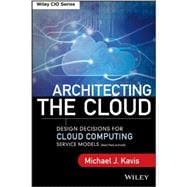
What is included with this book?
MICHAEL J. KAVIS is Principal Architect at Cloud Technology Partners, a vendor independent, cloud-exclusive, nimble alternative to large technology consultants. He has served in numerous technical roles such as CTO, Chief Architect, and Vice President and has over 25 years of experience in software development and architecture. Kavis is a pioneer in cloud computing and led a team that built the world’s first high-speed transaction network in Amazon’s public cloud. He is the former CTO of startup M-Dot Network, which won the 2010 Amazon AWS Global Startup Challenge.
Foreword
Preface
Acknowledgments
About the Author
Chapter 1 Why Cloud, Why Now?
Evolution of Cloud Computing
Enter the Cloud
Startup Case Study: Instagram, From Zero to a Billion Overnight
Established Company Case Study: Netflix, Shifting from on-premises to the cloud
Government Case Study: NOAA, Email and collaboration in the cloud
Not for profit Case Study: Obama Campaign, 6 month shelf life with one big peak
Sumary
References
Chapter 2 Cloud Service Models
Infrastructure as a Service
Platform as a Service
Software as a Service
Deployment Models
Summary
References
Chapter 3 Cloud Computing Worst Practices
Avoiding Failure when Moving to the Clouds
Migrating Applications to the cloud
Misguided Expectations
Misinformed about Cloud Security
Selecting a Favorite Vendor, not an Appropriate Vendor
Outages and Out of Business Scenarios
Underestimating the Impacts of Organizational Change
Skills Shortage
Misunderstanding Customer Requirements
Unexpected Costs
Summary
References
Chapter 4 It Starts with Architecture
The Importance of Why, Who, What, Where, When, and How
Start with the Business Architecture
A pragmatic appproach for building cloud services
Define the problem statement (Why)
Evaluate user characteristics (Who)
Identify business and technical requirements (What)
Visualize the service consumer experience (Where)
Identify the project constraints (When and With What)
Understand current state constraints (How)
Summary
References
Chapter 5 Choosing the Right Cloud Service Model
Considerations when Choosing a Cloud Service Model
When to use SaaS
When to use PaaS
When to use IaaS
Common cloud use cases
Summary
References
Chapter 6 The Key to the Cloud
RESTful Services
Why REST
The Challenges of Migrating Legacy Systems to the Cloud
Summary
References
Chapter 7 Auditing in the Cloud
Data and cloud security
Auditing cloud applications
Regulations in the Cloud
Audit design strategies
Summary
References
Chapter 8 Data Considerations in the Cloud
Data characteristics
Multi-tenant or single tenant
Choosing data store types
Summary
References
Chapter 9 Security Design in the Cloud
The Truth about Data in the Cloud
How Much Security is Required
Responsibilities for each Cloud Service Model
Security Strategies
Areas of Focus
Summary
References
Chapter 10 Creating a Centralized Logging Strategy
Log File Uses
Log File Requirements
Summary
References
Chapter 11 SLA Management
Factors that impact SLAs
Defining SLAs
Managing Vendor SLAs
Summary
References
Chapter 12 Monitoring Strategies
Proactive vs. Reactive Monitoring
What needs to be monitored?
Monitoring Strategies by Category
Monitoring by Cloud Service Level
Summary
References
Chapter 13 Disaster Recovery Planning
What is the cost of downtime?
Disaster Recovery Strategies for IaaS
Recovering from a disaster in the primary datacenter
Disaster Recovery Strategies for PaaS
Disaster Recovery Strategies for SaaS
Disaster Recovery Hybrid Clouds
Summary
Chapter 14 Leveraging a DevOps Culture to Deliver Software Faster and more Reliable
Developing the DevOps Mindset
Automate Infrastructure
Automate Deployments
Design Feature Flags
Measure, Monitor, and Experiment
Continuous Integration and Continuous Delivery
Summary
References
Chapter 15 Assessing the Organizational Impact of the Cloud Model
Enterprise Model vs. Elastic Compute Model
IT impact
Business Impacts
Organization change planning
Change in the real world
Summary
References
Chapter 16 Final Thoughts
The Cloud is evolving rapidly
Cloud Culture
New Business Models
PaaS is the Game Changer
Summary
Index
The New copy of this book will include any supplemental materials advertised. Please check the title of the book to determine if it should include any access cards, study guides, lab manuals, CDs, etc.
The Used, Rental and eBook copies of this book are not guaranteed to include any supplemental materials. Typically, only the book itself is included. This is true even if the title states it includes any access cards, study guides, lab manuals, CDs, etc.